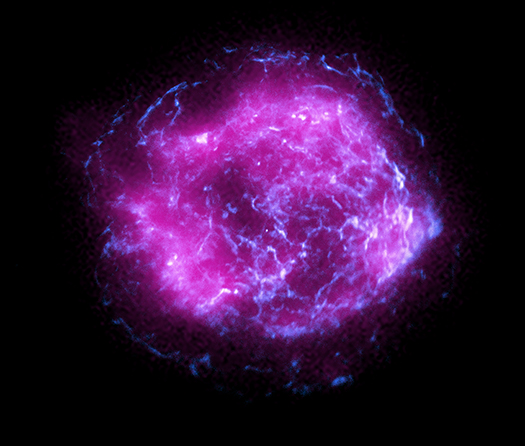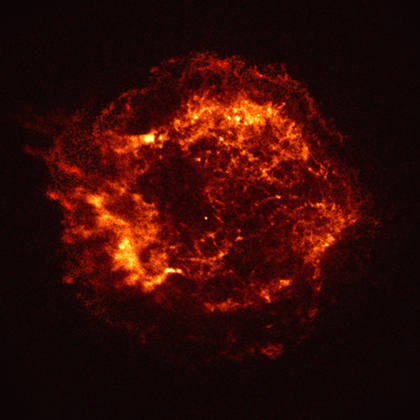NASA's IXPE Sends First Science Image

Cassiopeia A
Credit: NASA/CXC/SAO/IXPE
NASA’s Imaging X-Ray Polarimetry Explorer, which launched into space Dec. 9, 2021, delivered its first imaging data since completing its month-long commissioning phase.
All instruments are functioning well aboard the observatory, which is on a quest to study some of the most mysterious and extreme objects in the universe.
IXPE first focused its X-ray eyes on Cassiopeia A (Cas A), an object consisting of the remains of a star that exploded in the 17th century. The shock waves from the explosion have swept up surrounding gas, heating it to high temperatures and accelerating cosmic ray particles to make a cloud that glows in X-ray light. Other telescopes, including Chandra, have studied Cas A before, but IXPE will allow researchers to examine it in a new way.
The newly-release image combines IXPE and Chandra data of Cas A. The saturation of the magenta color corresponds to the intensity of X-ray light observed by IXPE, which has been overlaid on high-energy X-rays, shown in blue, from Chandra. With different kinds of detectors, Chandra and IXPE have different levels of angular resolution, or sharpness. The IXPE data in this new image contain collected from Jan. 11 to 18, while the Chandra data come from observations over the 22-year mission thus far.

Cassiopeia A, Chandra 1999
After Chandra launched in 1999, its first image was also of Cas A. Chandra’s X-ray imagery revealed, for the first time, that there is a compact object in the center of the supernova remnant, which may be a black hole or neutron star.
“The IXPE image of Cassiopeia A is as historic as the Chandra image of the same supernova remnant,” said Martin C. Weisskopf, the IXPE principal investigator based at NASA’s Marshall Space Flight Center in Huntsville, Alabama. “It demonstrates IXPE’s potential to gain new, never-before-seen information about Cassiopeia A, which is under analysis right now.”
A key measurement that scientists will make with IXPE is called polarization, a way of looking at how X-ray light is oriented as it travels through space. The polarization of light contains clues to the environment where the light originated. IXPE’s instruments also measure the energy, the time of arrival, and the position in the sky of the X-rays from cosmic sources.
“The IXPE image of Cassiopeia A is bellissima, and we look forward to analyzing the polarimetry data to learn even more about this supernova remnant,” said Paolo Soffitta, the Italian principal investigator for IXPE at the National Institute of Astrophysics (INAF) in Rome.
With polarization data from Cassiopeia A, IXPE will allow scientists to see, for the first time, how the amount of polarization varies across the supernova remnant, which is about 10 light-years in diameter. Researchers are currently working with the data to create the first-ever X-ray polarization map of the object. This will reveal new clues about how X-rays are produced at Cassiopeia A.
“IXPE's future polarization images should unveil the mechanisms at the heart of this famous cosmic accelerator,” said Roger Romani, an IXPE co-investigator at Stanford University. “To fill in some of those details, we’ve developed a way to make IXPE’s measurements even more precise using machine learning techniques. We’re looking forward to what we’ll find as we analyze all the data.”
IXPE launched on a Falcon 9 rocket from Cape Canaveral, and now orbits 370 miles (600 kilometers) above Earth’s equator. The mission is a collaboration between NASA and the Italian Space Agency with partners and science collaborators in 12 countries. Ball Aerospace, headquartered in Broomfield, Colorado, manages spacecraft operations.
Please note this is a moderated blog. No pornography, spam, profanity or discriminatory remarks are allowed. No personal attacks are allowed. Users should stay on topic to keep it relevant for the readers.
Read the privacy statement
